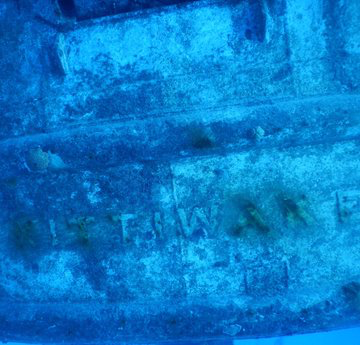After breakfast we drove to a secondary dock and got picked up by the 42ft long dive boat. Our first dive site of the day was the legendary USS Kittiwake. Known for being a submarine rescue vessel, and for picking up the Challenger’s blackbox after the infamous explosion, it is a well sought after wreck. The location of the wreck is conveniently located off 7 Mile Beach on Grand Cayman. At this spot the water is so clear that snorkelers can’t see the ship 60ft above at the surface. The ship itself is a251ft long, 2,200 ton, giant. Commissioned in 1945, the ship’s vintage layout prominently displays steel masts, railings, pumps, and a massive propeller on the outside. Looking through holes, windows, and doors, divers can also see all five decks and rooms such as the recreation room, mess hall, crew quarters, navigation room, and main deck. Although not a whole lot of marine life is located here, it makes an excellent dive to see how the vegetation has grown over the ship in only 8 years. A decent number of coral, algae, and sponges have covered every surface of the ship. Gray angelfish could also be seen around the ship. They have a white head, grey body, and blue outline. With lengths up to 60cm and a tall thin body, these fish feed on sponges. The USS Kittiwake was a very cool experience, the only word that kept coming to me throughout the ship was “wow”. The second dive was also a wreck. This smaller ship was responsible for placing a telephone line between Grand Cayman and Little Cayman. It is named after the first doctor on Grand Cayman who generally worked on divers. Doc Poulson gave free checkups to dive instructors and was the first person to bring over a hyperbaric chamber to the island. This wreck had much more vegetation, especially since it was sunk in 1984. Before the USS Kittiwake, it was the #1 wreck site, but in the last 8 years has seen a lot less traffic allowing algae, coral, and sponges to flourish. More fish were also at this site. It being more of a sandy area instead of reef, many garden eels like the ones I wrote about yesterday were seen. There was also a Spotted Moray Eel that I saw in a small cave. They have snake-like bodies that can grow up to 2m (6.6ft) and have a black body with white spots. Spotted morays are solitary animals, and usually hide in narrow crevices and holes in reef structures with only their heads peeking out. They are active during the day, feeding on crustaceans and fish at or near the sea bottom. Both the Grey Angelfish and Moray Eel were incredible to see in their natural habitats. It’s incredible how different the worlds of land and sea are, and I’m so glad I’ve been given this experience to see both in a whole new perspective.




